Part 3: The Midterm Senate Races To Watch
By Jefferson Fenner – Syracuse, N.Y. (CitrusTV) – In our third and final part of our election preview, we look at Senate races across the country that you need to watch. The Democrats can take back the Senate by winning only two more seats, however, that may be easier said than done, as forecasts predict the Senate will stay red in this cycle. Most of the seats in this race are blue, so to differentiate, we will be putting an asterisk in front of seats that are currently held by Republicans.
1. Arizona*
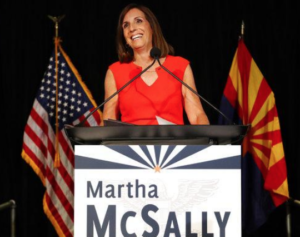
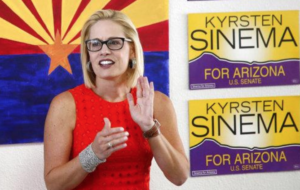
The winner of this race will become the first female Senator in Arizona’s history.
Both Sinema and McSally are Arizona Representatives competing for the seat of outgoing Senator Jeff Flake. McSally was able to defeat challenges from right-wing candidates Kelli Ward and Joe Arpaio. Now McSally, an Air Force veteran who was the first woman to command a fighter squadron, has been able to take control of this race on her own terms. She has highlighted her focus on veterans while in Congress, including a bill that helped to prioritize veterans for Border Patrol jobs.
Sinema has used her childhood, where she experienced homelessness and poverty before going to college and then Congress, as an example of the adversity she has been able to overcome. She has also shown herself to be a bipartisan legislator, after a govtrack.us report showed that 60.8% of the bills she co-sponsored were introduced Republicans.
Previous comments from Sinema have hurt her. She has previously referred to stay-at-home mothers as “leeches,” and once called Republican lawmakers in Arizona crazy. Despite these comments, poll numbers since September have gone back and forth giving either candidate as much as a six-point lead.
2. California

A weird primary process sees two democrats competing for the same spot.
California’s open primary process doesn’t see party’s candidates compete with each other for a nomination. Instead, every candidate that seeks the nomination runs against each other, and the top two vote-getters from this race run against each other in the general election.
Out of a whopping 33 candidates, incumbent democrat Dianne Feinstein and a fellow Democrat Kevin de Leon emerged and will run in the general election. De Leon may have received the nomination of the California Democratic Party, but Feinstein, one of the pillars of the Democrats in Congress, should still overwhelmingly win this race.
3. Florida

This is yet another close race in Flordia with two popular candidates.
Bill Nelson has served on Capitol Hill since 1979, and has been a Senator since 2000. Combined with his service in the Vietnam War, Nelson has been a public servant for over forty years. He has centered his campaign on his dedication to the state, and his platforms dedication to funding education and healthcare.
Rick Scott has been Governor of Florida since 2011 and has overseen multiple successes and tragedies in his time in office. He has grown the Florida economy substantially and has funded the expansion of school choice in the state, but he’s also had to deal with multiple natural disasters as well as the Parkland shooting. Despite his share of hardships, Scott has remained a popular governor among conservative Floridians from all walks.
This has been polling as a close race, given the popularity of both politicians. Most have gone for Nelson, but, excluding one poll giving him an eight point lead, they’ve been close. This could be a race that takes until midnight to call, so crack open the coffee pot for this one.
4. Indiana
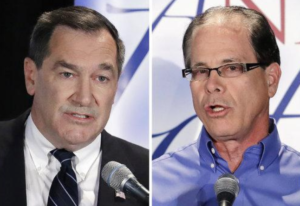
A tight race in the Hoosier State could lead to an upset on Tuesday night.
Joe Donnelly made waves in 2014 when he managed to flip a seat that had been Republican since 1976. Since arriving in Washington, he has made himself become a key bi-partisan Democrat. He supports the Affordable Care Act and was an opponent of the GOP Tax Bill, but he is in favor of some of Trump’s ideas including the border wall.
His opponent, Mike Braun is a staunch supporter of the President and has aligned himself with Trump on issues such as tariffs and tax cuts. In a state as red as Indiana, Braun has presented his Christian values and his ties to the state as a central issue in his campaign.
Polls in this race have taken a drastic turn in the last few weeks, with both candidates having four-point leads. This one could come down to the support of President Trump and Vice President Mike Pence, who served one term as Governor of Indiana. Trump won the state by nearly 20 points and the support of the White House could be enough for Braun to go over the top.
5. Missouri
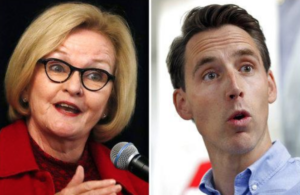
This is the seat that is most likely to flip red and is one of the biggest reasons why Democrats are projected to fail to take back the Senate.
Claire McCaskill isn’t a bad candidate. She’s been a socially liberal, fiscally conservative Democrat who has managed to vote yes on major liberal issues surrounding immigration and healthcare while advocating for lower taxes.
She’s running against the state’s Attorney General Josh Hawley, a charismatic young Republican who has previously gone after pharmaceutical and tech companies. He also went after former Missouri Governor Eric Greitens, who resigned amidst a sexual assault and harassment scandal.
Polls have shown a clear favorite in Hawley, with three polls in the last month showing him having a slight lead. But, with high margins of undecided voters, this could come down to the wire.
6. Nevada*
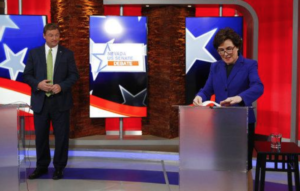
A close race in the Southwest gives the Democrats a chance to pick up a seat they need in order to flip the Senate.
Rep. Jacky Rosen’s district (NV-3) makes up about one-fourth of the state’s population. She has been bi-partisan in Congress as a member of the 48 member Problem Solvers Caucus, and uses this as a chance to distance herself from Heller, who she calls, “Senator Spineless”
Heller has support from the President, which makes sense given how often Heller supports his ideas. A FiveThirtyEight analysis of the 115th Congress shows Heller votes with Trump’s positions 92% of the time, including on issues like repealing the Affordable Care Act.
Both parties recognize the importance of this race and have brought out the big guns. Heller has received support from Trump and Pence and Rosen has hosted rallies attended by former President Obama, former VP Joe Biden, and Sen. Bernie Sanders. Polls have been all over the place, but one speaks to the testament of how close this race is. A Vox Populi poll of over 600 voters from mid-October gave respondents a Democrat v. Republican poll with no undecided option. The result was a dead tie: 44% – 44%.
7. New Jersey
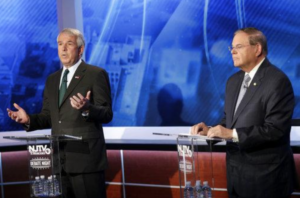
An at-risk Democrat in a blue state makes this race one to watch.
Sen. Bob Menendez went through a corruption trial that captured national attention in 2015. However, a mistrial was declared due to a hung jury, with one juror saying 10 out of 12 jurors planned to acquit him. The Justice Department eventually dropped all charges against him. Despite this, the Senate Ethics Committee admonished him in a letter saying they found he was corrupt.
His opponent, pharmaceutical executive Bob Hugin, may be equally corrupt. He has worked hard to prevent generic alternative medication of cancer drugs produced by his company, Celgene. There’s also the case of a $280 million settlement surrounding improper marketing techniques that were revealed via whistleblowers. Hugin’s campaign has also produced an advertisement that accuses Menendez of soliciting prostitutes and minors in the Dominican Republic, which a New York Times fact check calls “unsubstantiated allegations.”
The mud-slinging in this race has not sit well with voters. The Newark Star-Ledger, in their endorsement of Menendez, acknowledged there was no choice that was far superior saying, “This year’s U.S. Senate race presents the most depressing choice for New Jersey voters in a generation, with two awful candidates whose most convincing argument is that the other guy is unfit to serve.”
8. North Dakota

An incumbent’s record of voting blue may cost her seat in a red state.
Sen. Heitkamp has been a critic of many of the President’s major policies and has voted against Trump on the nomination of Brett Kavanaugh and the overhaul of the tax code. Despite this, she has voted with Trump 54% of the time.
But in a state that went for Trump by 35 points, this probably won’t be enough to keep it blue. Her opponent, Rep. Kevin Cramer has Trump’s endorsement and supports his policy of tax cuts.
The writing is on the wall. Each poll since mid-September has given Cramer at least a 9 point lead. It’s very likely Heitkamp will be out of office come January.
9. Tennessee*

A former face has brought life to this race in the Volunteer State.
After Sen. Bob Corker chose to step down, Rep. Marsha Blackburn stepped up to become the Republican nominee for this seat. A staunch Trump supporter, Blackburn has launched campaign ads supporting the border wall, ending sanctuary cities and deporting illegal immigrants who committed crimes. In a state that went for Trump by 26 points, and last had a Democratic senator in 1994, this should’ve been an easy seat to win back.
Enter Phil Bredesen, the popular former Democratic governor of the state, who is moderate enough to win over a red state’s governorship twice. His campaign has run on his experience in office and has tried to build on his old track record of running the state’s economy by advocating for healthcare improvement, education funding and overall economic wellbeing.
Polling wise, Blackburn has lead most of the time with high rates of undecided voters. All signs are pointing towards her keeping this seat red.
10. Texas*
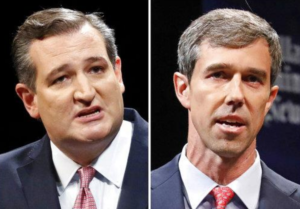
There may be no race this year that has captured more attention across social media and television than the race for Texas’s senate seat.
Ted Cruz has been a fixture in the Republican party ever since he led the effort to cause a government shutdown in 2013, which featured a 21-hour speech to hold up a funding bill. Cruz ran a campaign for president and won twelve primaries, including Iowa, Wisconsin and his home state of Texas before dropping out in May of 2016. He has courted favor of fellow Texans by opposing gun control and authored a NASA bill which kept aerospace jobs in the state. Despite his quarrels with the President, Cruz has toed the Republican line and voted with Trump 91% of the time.
Texas hasn’t been a blue state since Jimmy Carter ran for President and Cruz’s seat had seemed to be all but locked up. Then, Rep. Beto O’Rourke, a young Democrat from El Paso won the party nomination by nearly 400,000 votes. Spurred on by a massive grassroots campaign targeting Texas’s progressive young people, O’Rourke has made a name for himself on the national stage with some even speculating he could run for the White House in 2020. O’Rourke has presented a more progressive platform emphasizing abortion, gun violence and healthcare coverage.
Every poll has gone Cruz’s way, but Texas has been trending blue for the last few years. If O’Rourke’s hope that every democrat votes comes true, he could pull off the biggest political upset of the year.
Images Courtesy of AP Images

